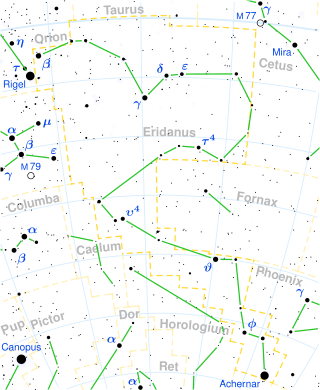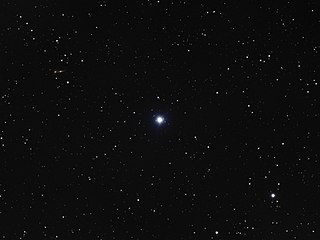Related Research Articles
Gamma Sextantis, Latinized as γ Sextantis, is a binary star system in the equatorial constellation of Sextans. The combined apparent visual magnitude of the system is 5.05, which means it is faintly visible to the naked eye. The annual parallax shift is 11.75 mas, indicating a distance of around 280 light years.

Chi Aquilae is the Bayer designation for a binary star in the equatorial constellation of Aquila, the eagle. This system is bright enough to be seen with the naked eye at a combined visual magnitude of +5.29. Based upon parallax measurements made during the Hipparcos mission, Chi Aquilae is at a distance of approximately 900 light-years from Earth.
39 Boötis is a triple star system located around 224 light years away from the Sun in the northern constellation of Boötes. It is visible to the naked eye as a faint, yellow-white hued star with a combined apparent magnitude of 5.68. The system is moving closer to the Earth with a heliocentric radial velocity of −31 km/s.

28 Cancri is a star system in the zodiac constellation of Cancer. It is a variable star with the designation CX Cancri, and is close to the lower limit of visibility with the naked eye, having a mean apparent visual magnitude of 6.05. The annual parallax shift seen from Earth's orbit is 8.5 mas, which provides a distance estimate of about 384 light years. It is moving away from the Sun with a radial velocity of around +9 km/s.
7 Camelopardalis is a multiple star system in the northern circumpolar constellation of Camelopardalis. It is located approximately 370 light years from the Sun, as determined from its parallax. This system is visible to the naked eye as a faint, white-hued star with a combined apparent visual magnitude of 4.43. It is moving closer to the Earth with a heliocentric radial velocity of −10 km/s.

Pi Cassiopeiae, Latinized from π Cassiopeiae, is a close binary star system in the constellation Cassiopeia. It is visible to the naked eye with an apparent visual magnitude of +4.949. Based upon an annual parallax shift of 18.63 mas as seen from Earth, this system is located about 175 light years from the Sun.

Omega Cassiopeiae is a binary star system in the northern constellation of Cassiopeia. It has a combined apparent visual magnitude of +4.99, which means it is a faint star but visible to the naked eye. Based upon an annual parallax shift of 4.65 mas as seen from Earth, this system is located roughly 730 light years from the Sun. At that distance, the visual magnitude is diminished by an extinction of 0.16 due to interstellar dust.
3 Centauri is a triple star system in the southern constellation of Centaurus, located approximately 300 light years from the Sun. It is visible to the naked eye as a faint, blue-white hued star with a combined apparent visual magnitude of 4.32. As of 2017, the two visible components had an angular separation of 7.851″ along a position angle of 106°. The system has the Bayer designation k Centauri; 3 Centauri is the Flamsteed designation. It is a suspected eclipsing binary with a variable star designation V983 Centauri.
Theta Pictoris is a star in the Pictor constellation.

Tau5 Eridani, Latinized from τ5 Eridani, is a binary star system in the constellation Eridanus. It is visible to the naked eye with a combined apparent visual magnitude of 4.26. The distance to this system, as estimated using the parallax technique, is around 293 light years.
52 Hydrae is a triple star system in the constellation Hydra. It has the Bayer designation l Hydrae; 52 Hydrae is the Flamsteed designation. This system is visible to the naked eye as a faint, blue-white hued star with an apparent visual magnitude of 4.97. It is a probable member of the Sco OB2 moving group of stars, and is moving away from the Earth with a heliocentric radial velocity of 5 km/s.
η Lupi, often Latinised as Eta Lupi, is a probable triple star system in the southern constellation of Lupus. It is visible to the naked eye with an apparent visual magnitude of 3.41. Based upon an annual parallax shift of 27.80 mas as seen from Earth, it is located around 136 parsecs (440 ly) distant from the Sun. It is a member of the Upper Centaurus–Lupus subgroup of the nearby Sco OB2 association.

KT Lupi is a visual binary star system in the constellation Lupus. It is visible to the naked eye with a combined apparent visual magnitude of 4.55. As of 1983, the pair had an angular separation of 2.19″±0.03″. Based upon an annual parallax shift of 7.6 mas as seen from Earth's orbit, it is located 430 light-years from the Sun. The system is moving further from the Earth with a heliocentric radial velocity of +6.5 km/s. It is a member of the Lower Centaurus–Crux sub-group of the Scorpius–Centaurus association.

2 Lyncis is a binary star system in the northern constellation Lynx. It is visible to the naked eye, having an apparent visual magnitude of 4.44. The distance to this system, judging by an annual parallax shift of 20.83±0.40 mas, is around 157 light years. It is moving closer to the Sun with a heliocentric radial velocity of −2 km/s.
Epsilon Normae, Latinised from ε Normae, is a blue-white hued triple star system in the southern constellation of Norma. It has an apparent visual magnitude of 4.47, which is bright enough to be seen with the naked eye. Based upon an annual parallax shift of 6.15 mas as seen from Earth, the system is located around 530 light years distant from the Sun. At that distance, the visual magnitude is diminished by an extinction factor of 0.21 due to interstellar dust.

Nu Pavonis is a possible triple star system in the southern constellation of Pavo. It is visible to the naked eye as a faint star that varies in apparent visual magnitude from 4.60 to 4.64 over a period of 0.85584 days. The system lies approximately 440 light years from the Sun based on parallax, and is drifting further away with a radial velocity of +17 km/s. It is a possible member of the Wolf 630 group of co-moving stars.

43 Persei is a binary star system in the northern constellation Perseus. It is visible to the naked eye as a dim, yellow-white hued star with an apparent visual magnitude of 5.28. The system is located around 38.5 parsecs (125.4 ly) distant from the Sun, based on parallax.

Theta2 Microscopii is a class A0III star in the constellation Microscopium. Its apparent magnitude is 5.76 and it is approximately 390 light years away based on parallax. It is an Ap star, a chemically peculiar star with unusually strong metallic spectral lines.
ω Leonis, is a star system located in the zodiac constellation of Leo. It is visible to the naked eye in the absence of light pollution, with an apparent visual magnitude of about 5.4. The distance to this star, as determined using parallax measurements, is around 108 light years from the Sun. Because of its location close to the ecliptic, it is subject to being obscured by the Moon, and potentially by planets.
μ Librae is the Bayer designation for a probable triple star system in the zodiac constellation of Libra. They have a combined apparent visual magnitude of 5.32, which is bright enough to be faintly visible to the naked eye. With an annual parallax shift of 13.71 mas, the system is located at an estimated distance of around 240 light years.
References
- 1 2 3 4 5 6 van Leeuwen, F.; et al. (2007). "Validation of the new Hipparcos reduction". Astronomy and Astrophysics. 474 (2): 653–664. arXiv: 0708.1752 . Bibcode:2007A&A...474..653V. doi:10.1051/0004-6361:20078357. S2CID 18759600. Archived from the original on 2016-04-02.
- 1 2 3 4 Anderson, E.; Francis, Ch. (2012), "XHIP: An extended hipparcos compilation", Astronomy Letters, 38 (5): 331, arXiv: 1108.4971 , Bibcode:2012AstL...38..331A, doi:10.1134/S1063773712050015, S2CID 119257644.
- 1 2 "Sixth Catalog of Orbits of Visual Binary Stars". United States Naval Observatory. Archived from the original on 1 August 2017. Retrieved 28 May 2017.
- 1 2 3 4 5 6 Howe, K. S.; Clarke, C. J. (January 2009). "An analysis of v sin (i) correlations in early-type binaries". Monthly Notices of the Royal Astronomical Society . 392 (1): 448–454. Bibcode:2009MNRAS.392..448H. doi: 10.1111/j.1365-2966.2008.14073.x .
- ↑ Johnson, H. L. (1966). "UBVRIJKL Photometry of the Bright Stars". Communications of the Lunar and Planetary Laboratory. 4: 99. Bibcode:1966CoLPL...4...99J.
- ↑ Gontcharov, G. A. (2006). "Pulkovo Compilation of Radial Velocities for 35 495 Hipparcos stars in a common system". Astronomy Letters. 32 (11): 759–771. arXiv: 1606.08053 . Bibcode:2006AstL...32..759G. doi:10.1134/S1063773706110065. S2CID 119231169.
- ↑ "* 12 Lyn". SIMBAD . Centre de données astronomiques de Strasbourg . Retrieved 20 November 2012.
- ↑ Eggleton, P. P.; Tokovinin, A. A. (September 2008). "A catalogue of multiplicity among bright stellar systems". Monthly Notices of the Royal Astronomical Society . 389 (2): 869–879. arXiv: 0806.2878 . Bibcode:2008MNRAS.389..869E. doi: 10.1111/j.1365-2966.2008.13596.x . S2CID 14878976.
- ↑ Mason, Brian D.; et al. (2001), "The 2001 US Naval Observatory Double Star CD-ROM. I. The Washington Double Star Catalog", The Astronomical Journal, 122 (6): 3466, Bibcode:2001AJ....122.3466M, doi: 10.1086/323920 .
- ↑ Monks, Neale (2010). Go-To Telescopes Under Suburban Skies. New York, New York: Springer Science & Business Media. p. 56. ISBN 9781441968517.
- ↑ Malkov, O. Yu.; Tamazian, V.S.; Docobo, J.A.; Chulkov, D.A. (2012). "Dynamical Masses of a Selected Sample of Orbital Binaries". Astronomy and Astrophysics. 546: 5. Bibcode:2012A&A...546A..69M. doi: 10.1051/0004-6361/201219774 . A69.